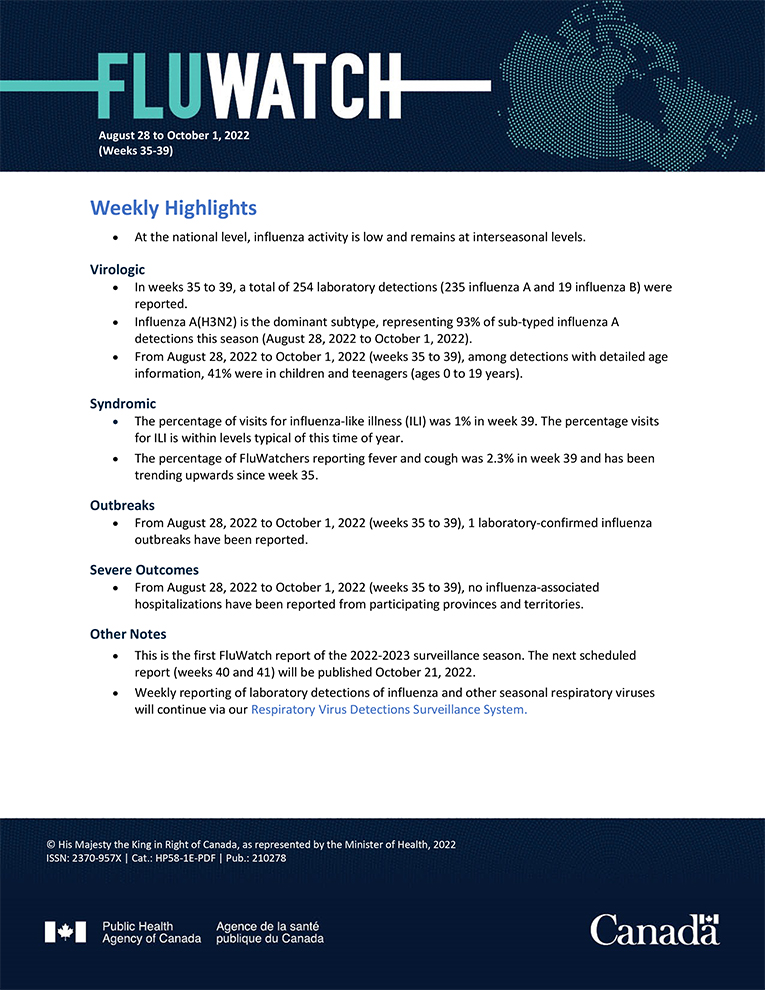FluWatch report: August 28 to October 1, 2022 (weeks 35-39)
Download in PDF format
(2.07 MB, 9 pages)
Organization: Public Health Agency of Canada
Published: 2022-10-07
Related Topics
Weekly Highlights
- At the national level, influenza activity is low and remains at interseasonal levels.
Virologic
- In weeks 35 to 39, a total of 254 laboratory detections (235 influenza A and 19 influenza B) were reported.
- Influenza A(H3N2) is the dominant subtype, representing 93% of sub-typed influenza A detections this season (August 28, 2022 to October 1, 2022).
- From August 28, 2022 to October 1, 2022 (weeks 35 to 39), among detections with detailed age information, 41% were in children and teenagers (ages 0 to 19 years).
Syndromic
- The percentage of visits for influenza-like illness (ILI) was 1% in week 39. The percentage visits for ILI is within levels typical of this time of year.
- The percentage of FluWatchers reporting fever and cough was 2.3% in week 39 and has been trending upwards since week 35.
Outbreaks
- From August 28, 2022 to October 1, 2022 (weeks 35 to 39), 1 laboratory-confirmed influenza outbreaks have been reported.
Severe Outcomes
- From August 28, 2022 to October 1, 2022 (weeks 35 to 39), no influenza-associated hospitalizations have been reported from participating provinces and territories.
Other Notes
- This is the first FluWatch report of the 2022-2023 surveillance season. The next scheduled report (weeks 40 and 41) will be published October 21, 2022.
- Weekly reporting of laboratory detections of influenza and other seasonal respiratory viruses will continue via our Respiratory Virus Detections Surveillance System.
On this page
- Influenza/Influenza-like Illness Activity - Geographic Spread
- Laboratory-Confirmed Influenza Detections
- Syndromic / Influenza-like Illness Surveillance
- Influenza Outbreak Surveillance
- Influenza Severe Outcomes Surveillance
- Influenza Strain Characterization
- Antiviral Resistance
- Influenza Vaccine Monitoring
- Provincial and International Influenza Reports
Influenza/Influenza-like Illness Activity - Geographic Spread
In week 39, 14 regions in three provinces reported sporadic influenza activity (B.C., Ont., and N.S.) (Figure 1).
Number of Regions Reporting in Week 39: 36 out of 53
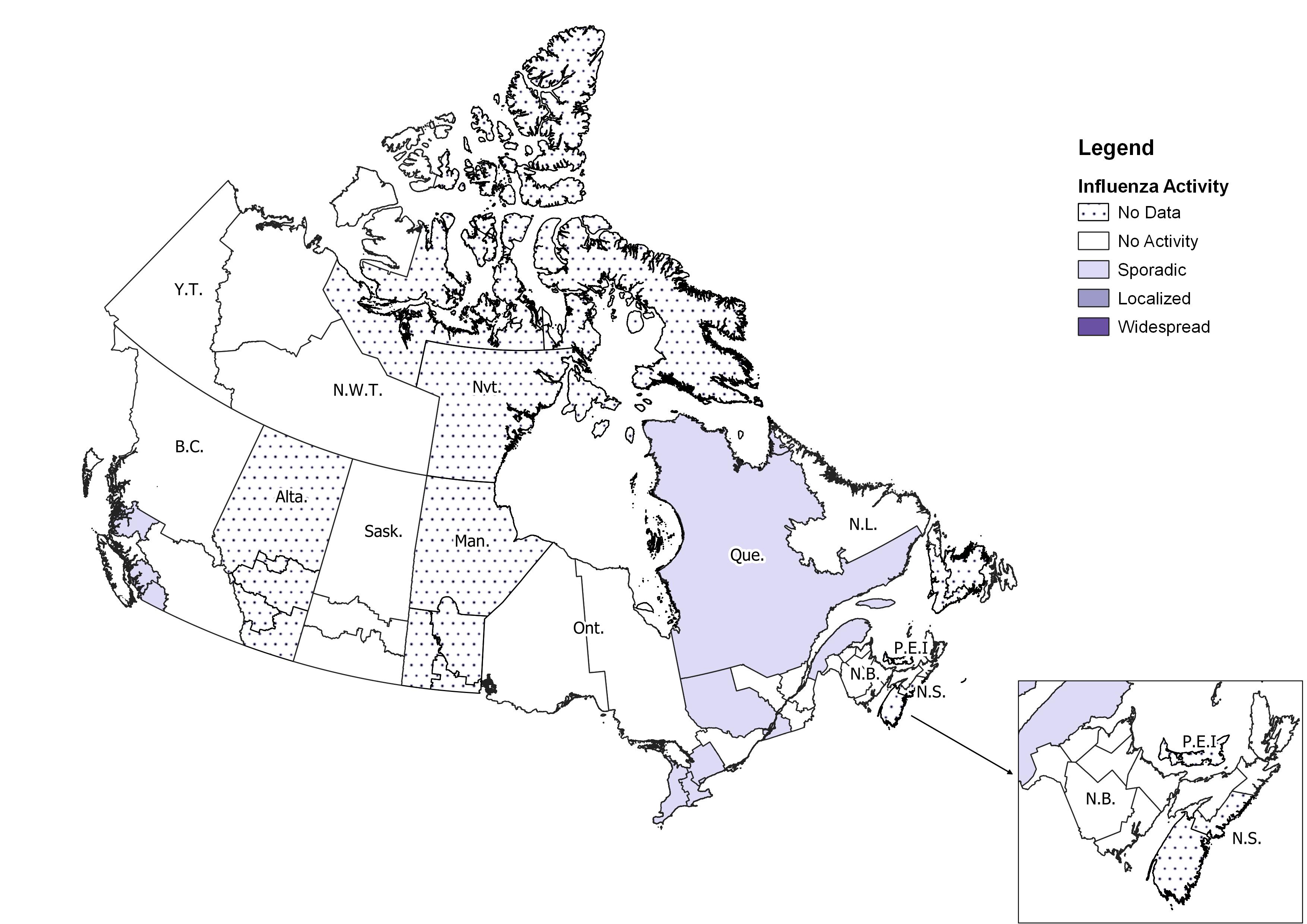
Figure 1 - Text description
| Province | Influenza Surveillance Region | Activity Level |
|---|---|---|
| N.L. | Eastern | No Activity |
| N.L. | Labrador-Grenfell | No Activity |
| N.L. | Central | No Data |
| N.L. | Western | No Data |
| P.E.I. | Prince Edward Island | No Data |
| N.S. | Zone 1 - Western | No Activity |
| N.S. | Zone 2 - Northern | Sporadic |
| N.S. | Zone 3 - Eastern | No Activity |
| N.S. | Zone 4 - Central | Sporadic |
| N.B. | Region 1 | No Activity |
| N.B. | Region 2 | No Activity |
| N.B. | Region 3 | No Activity |
| N.B. | Region 4 | No Activity |
| N.B. | Region 5 | No Activity |
| N.B. | Region 6 | No Activity |
| N.B. | Region 7 | No Activity |
| Que. | Nord-est | No Data |
| Que. | Québec et Chaudieres-Appalaches | No Data |
| Que. | Centre-du-Québec | No Data |
| Que. | Montréal et Laval | No Data |
| Que. | Ouest-du-Québec | No Data |
| Que. | Montérégie | No Data |
| Ont. | Central East | Sporadic |
| Ont. | Central West | Sporadic |
| Ont. | Eastern | Sporadic |
| Ont. | North East | Sporadic |
| Ont. | North West | Sporadic |
| Ont. | South West | Sporadic |
| Ont. | Toronto | Sporadic |
| Man. | Northern Regional | No Activity |
| Man. | Prairie Mountain | No Activity |
| Man. | Interlake-Eastern | No Activity |
| Man. | Winnipeg | No Activity |
| Man. | Southern Health | No Activity |
| Sask. | North | No Activity |
| Sask. | Central | No Activity |
| Sask. | South | No Activity |
| Alta. | North Zone | No Data |
| Alta. | Edmonton | No Data |
| Alta. | Central Zone | No Data |
| Alta. | Calgary | No Data |
| Alta. | South Zone | No Data |
| B.C. | Interior | Sporadic |
| B.C. | Fraser | Sporadic |
| B.C. | Vancouver Coastal | Sporadic |
| B.C. | Vancouver Island | Sporadic |
| B.C. | Northern | Sporadic |
| Y.T. | Yukon | No Activity |
| N.W.T. | North | No Activity |
| N.W.T. | South | No Activity |
| Nvt. | Qikiqtaaluk | No Data |
| Nvt. | Kivalliq | No Data |
| Nvt. | Kitimeot | No Data |
Laboratory-Confirmed Influenza Detections
In week 39, a total of 102 laboratory detections (98 influenza A and 4 influenza B) were reported. Influenza activity remains within the interseasonal levels typically seen at this time of year.
The following results were reported from sentinel laboratories across Canada in week 39 (Figures 2 and 3):
- The weekly percentage of tests positive for influenza increased from 0.2% in week 35 to 0.7% in week 39 and is within expected pre-pandemic levels.
- Among subtyped influenza A detections, 67.3% (35) were influenza A(H3N2) and 32.7% (17) were influenza A(H1N1).
To date this season (August 28, 2022 to October 1, 2022), 254 influenza detections were reported:
- 93% (235) were influenza A.
- Among subtyped influenza A detections (136), influenza A(H3N2) accounted for 68% of detections.
Detailed information on age and type/subtype has been received for 182 laboratory-confirmed influenza detections (Figure 4). Among the 182 detections, 74 (41%) were in individuals aged 0-19 years old and 45 (25%) were in individuals 20-44 years old.
For more detailed weekly and cumulative influenza data, see the text descriptions for Figures 2 and 3 or the Respiratory Virus Detections in Canada Report.
Number of Laboratories Reporting in Week 39: 33 out of 34
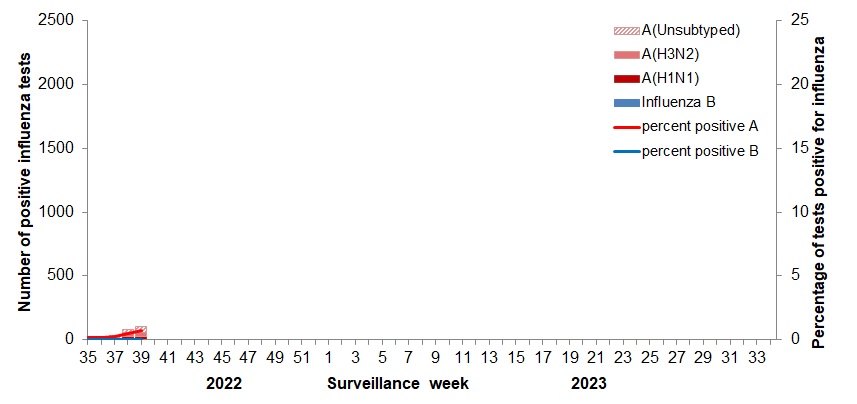
Figure 2 - Text description
| Surveillance Week | A(Unsubtyped) | A(H3N2) | A(H1N1) | Influenza B | Percent Positive A | Percent Positive B |
|---|---|---|---|---|---|---|
| 35 | 13 | 10 | 2 | 3 | 0.2 | 0.0 |
| 36 | 9 | 5 | 1 | 6 | 0.1 | 0.1 |
| 37 | 18 | 9 | 3 | 3 | 0.2 | 0.0 |
| 38 | 26 | 34 | 20 | 3 | 0.5 | 0.0 |
| 39 | 46 | 35 | 17 | 4 | 0.7 | 0.0 |
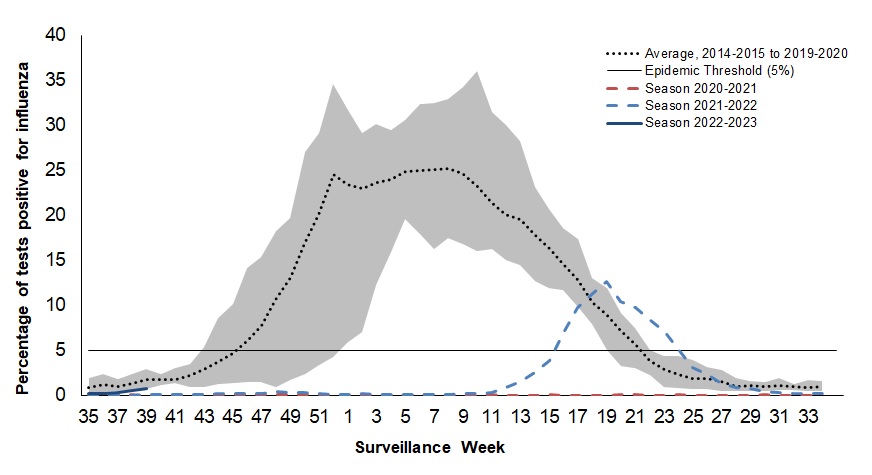
The shaded area represents the maximum and minimum number of influenza tests or percentage of tests positive reported by week from seasons 2014-2015 to 2019-2020. Data from week 11 of the 2019-2020 season onwards are excluded from the historical comparison due to the COVID-19 pandemic.
The epidemic threshold is 5% tests positive for influenza. When it is exceeded, and a minimum of 15 weekly influenza detections are reported, a seasonal influenza epidemic is declared.
Figure 3 - Text description
| Surveillance Week | Percentage of tests positive, 2022-2023 | Percentage of tests positive, 2021-2022 | Percentage of tests positive, 2020-2021 | Maximum Percentage of Tests Positive | Minimum Percentage of Tests Positive | Average Percentage of Tests Positive |
|---|---|---|---|---|---|---|
| 35 | 0.2 | 0.0 | 0.0 | 1.9 | 0.1 | 0.8 |
| 36 | 0.2 | 0.0 | 0.0 | 2.3 | 0.3 | 1.1 |
| 37 | 0.3 | 0.0 | 0.0 | 1.8 | 0.4 | 1.0 |
| 38 | 0.5 | 0.0 | 0.0 | 2.4 | 0.5 | 1.3 |
| 39 | 0.7 | 0.0 | 0.0 | 2.9 | 0.7 | 1.7 |
| 40 | N/A | 0.0 | 0.0 | 2.3 | 1.1 | 1.7 |
| 41 | N/A | 0.1 | 0.0 | 3.0 | 1.3 | 1.7 |
| 42 | N/A | 0.1 | 0.0 | 3.4 | 0.9 | 2.2 |
| 43 | N/A | 0.1 | 0.0 | 5.3 | 0.8 | 2.8 |
| 44 | N/A | 0.2 | 0.1 | 8.5 | 1.2 | 3.7 |
| 45 | N/A | 0.1 | 0.0 | 10.1 | 1.4 | 4.6 |
| 46 | N/A | 0.2 | 0.0 | 14.1 | 1.5 | 6.1 |
| 47 | N/A | 0.2 | 0.1 | 15.4 | 1.4 | 7.7 |
| 48 | N/A | 0.3 | 0.1 | 18.2 | 0.8 | 10.6 |
| 49 | N/A | 0.3 | 0.0 | 19.7 | 1.6 | 13.0 |
| 50 | N/A | 0.3 | 0.0 | 27.0 | 2.4 | 16.8 |
| 51 | N/A | 0.2 | 0.0 | 29.1 | 3.3 | 20.1 |
| 52 | N/A | 0.1 | 0.0 | 34.5 | 4.3 | 24.5 |
| 1 | N/A | 0.1 | 0.0 | 31.7 | 5.8 | 23.4 |
| 2 | N/A | 0.1 | 0.0 | 29.1 | 7.1 | 23.0 |
| 3 | N/A | 0.1 | 0.0 | 30.1 | 12.2 | 23.6 |
| 4 | N/A | 0.1 | 0.0 | 29.5 | 15.9 | 24.0 |
| 5 | N/A | 0.0 | 0.0 | 30.6 | 19.6 | 24.9 |
| 6 | N/A | 0.1 | 0.0 | 32.4 | 17.9 | 25.0 |
| 7 | N/A | 0.0 | 0.0 | 32.5 | 16.3 | 25.1 |
| 8 | N/A | 0.1 | 0.0 | 32.9 | 17.5 | 25.1 |
| 9 | N/A | 0.1 | 0.0 | 34.3 | 16.8 | 24.6 |
| 10 | N/A | 0.2 | 0.0 | 36.0 | 16.0 | 23.2 |
| 11 | N/A | 0.3 | 0.0 | 31.4 | 16.2 | 21.4 |
| 12 | N/A | 0.9 | 0.0 | 30.0 | 15.0 | 20.1 |
| 13 | N/A | 1.5 | 0.0 | 28.3 | 14.5 | 19.6 |
| 14 | N/A | 2.5 | 0.0 | 23.2 | 12.7 | 17.9 |
| 15 | N/A | 3.9 | 0.0 | 20.7 | 11.9 | 16.3 |
| 16 | N/A | 7.0 | 0.0 | 18.5 | 11.6 | 14.5 |
| 17 | N/A | 9.7 | 0.0 | 17.3 | 9.8 | 12.8 |
| 18 | N/A | 11.3 | 0.0 | 13.0 | 7.9 | 10.3 |
| 19 | N/A | 12.6 | 0.0 | 11.9 | 5.0 | 9.0 |
| 20 | N/A | 10.4 | 0.0 | 9.1 | 3.2 | 7.2 |
| 21 | N/A | 9.8 | 0.0 | 7.4 | 3.0 | 5.6 |
| 22 | N/A | 8.4 | 0.0 | 5.0 | 2.2 | 3.9 |
| 23 | N/A | 7.0 | 0.0 | 4.4 | 0.9 | 2.9 |
| 24 | N/A | 5.0 | 0.0 | 4.4 | 0.8 | 2.2 |
| 25 | N/A | 3.0 | 0.0 | 3.9 | 0.6 | 1.9 |
| 26 | N/A | 2.3 | 0.0 | 3.1 | 0.7 | 1.8 |
| 27 | N/A | 1.2 | 0.0 | 2.8 | 0.4 | 1.5 |
| 28 | N/A | 0.8 | 0.0 | 1.8 | 0.4 | 0.9 |
| 29 | N/A | 0.7 | 0.0 | 1.6 | 0.5 | 1.1 |
| 30 | N/A | 0.4 | 0.0 | 1.5 | 0.5 | 0.9 |
| 31 | N/A | 0.3 | 0.0 | 1.9 | 0.6 | 1.1 |
| 32 | N/A | 0.2 | 0.0 | 1.2 | 0.5 | 0.9 |
| 33 | N/A | 0.2 | 0.0 | 1.7 | 0.4 | 0.9 |
| 34 | N/A | 0.2 | 0.0 | 1.6 | 0.4 | 0.9 |
Figure 4 - Proportion of positive influenza specimens by type or subtype and age-group reported through case-based laboratory reporting, Canada, week 2022-35 to 2022-39

Laboratory data notes:
Testing for influenza and other respiratory viruses has been influenced by the current COVID-19 pandemic. Changes in laboratory testing practices may affect the comparability of data to previous seasons.
Due to different testing protocols of laboratories across Canada, influenza A subtype detection counts may not be included in total influenza A detection counts. Some subtype detections are not available through routine testing but are subsequently reported if further subtype testing is conducted. In these instances, subtype counts do not reflect influenza A detections captured by routine surveillance, and are excluded from total detections and percent positivity.
Figure 4 - Text description
| Age Group | Proportion of Influenza A | Proportion of Influenza B | Total Number Influenza Detections |
|---|---|---|---|
| 0 to 4 | 85.7% | 14.3% | 28 |
| 5 to 19 | 93.5% | 6.5% | 46 |
| 20 to 44 | 93.3% | 6.7% | 45 |
| 45 to 64 | 100.0% | 0.0% | 25 |
| 65+ | 94.7% | 5.3% | 38 |
| Age Group | Proportion of A(H1N1) | Proportion of A(H3N2) | Total Number of Subtyped Influenza Detections |
|---|---|---|---|
| 0 to 4 | 33.3% | 66.7% | 12 |
| 5 to 19 | 23.3% | 76.7% | 30 |
| 20 to 44 | 14.3% | 85.7% | 28 |
| 45 to 64 | 47.1% | 52.9% | 17 |
| 65+ | 33.3% | 66.7% | 24 |
Syndromic / Influenza-like Illness Surveillance
Healthcare Practitioners Sentinel Surveillance
In week 39, 1% of visits to healthcare professionals were due to influenza-like illness (ILI). The percentage of visits for ILI is within levels typical of this time of year.
Since the beginning of the surveillance season, the percentage of visits for ILI has been within or near expected pre-pandemic levels (Figure 5). ILI symptoms are not specific to any one respiratory pathogen and can be due to influenza, or other respiratory viruses, including respiratory syncytial virus and even SARS-CoV-2, the virus that causes COVID-19.
This indicator should be interpreted with caution as there have been changes in healthcare seeking behavior of individuals and a smaller number of sentinels reporting compared to previous seasons.
Number of Sentinels Reporting in Week 39: 36
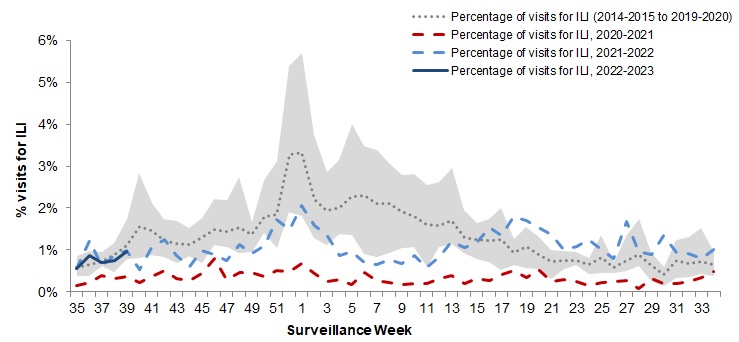
The shaded area represents the maximum and minimum percentage of percentage of participants reporting cough and fever by week, from seasons 2014-2015 to 2019-2020. Data from week 11 of the 2019-2020 season onwards are excluded from the historical comparison due to the COVID-19 pandemic.
Figure 5 - Text description
| Surveillance Week | 2022-2023 | 2021-2022 | 2020-2021 | Average | Min | Max |
|---|---|---|---|---|---|---|
| 35 | 0.6% | 0.6% | 0.1% | 0.6% | 0.4% | 0.9% |
| 36 | 0.9% | 1.2% | 0.2% | 0.6% | 0.4% | 0.9% |
| 37 | 0.7% | 0.6% | 0.4% | 0.7% | 0.5% | 1.0% |
| 38 | 0.8% | 0.9% | 0.3% | 0.7% | 0.6% | 1.0% |
| 39 | 1.0% | 1.0% | 0.4% | 0.9% | 0.5% | 1.2% |
| 40 | N/A | 0.5% | 0.2% | 1.2% | 0.8% | 1.7% |
| 41 | N/A | 1.1% | 0.4% | 1.7% | 0.8% | 2.8% |
| 42 | N/A | 1.2% | 0.5% | 1.6% | 1.2% | 2.1% |
| 43 | N/A | 0.9% | 0.3% | 1.2% | 0.8% | 1.7% |
| 44 | N/A | 0.6% | 0.3% | 1.2% | 0.7% | 1.7% |
| 45 | N/A | 1.0% | 0.4% | 1.2% | 0.9% | 1.5% |
| 46 | N/A | 0.9% | 0.8% | 1.4% | 1.2% | 1.8% |
| 47 | N/A | 0.7% | 0.3% | 1.6% | 1.1% | 2.2% |
| 48 | N/A | 1.1% | 0.5% | 1.5% | 1.1% | 2.2% |
| 49 | N/A | 0.9% | 0.5% | 1.7% | 1.0% | 2.8% |
| 50 | N/A | 1.1% | 0.4% | 1.5% | 1.1% | 1.7% |
| 51 | N/A | 1.7% | 0.5% | 1.9% | 1.4% | 2.7% |
| 52 | N/A | 1.5% | 0.5% | 2.0% | 1.0% | 3.1% |
| 1 | N/A | 2.1% | 0.7% | 3.4% | 1.9% | 5.4% |
| 2 | N/A | 1.6% | 0.4% | 3.4% | 1.8% | 5.7% |
| 3 | N/A | 1.4% | 0.2% | 2.3% | 1.3% | 3.7% |
| 4 | N/A | 0.9% | 0.3% | 2.0% | 1.1% | 2.9% |
| 5 | N/A | 1.0% | 0.2% | 2.1% | 1.4% | 3.1% |
| 6 | N/A | 0.7% | 0.5% | 2.4% | 1.4% | 4.0% |
| 7 | N/A | 0.7% | 0.3% | 2.4% | 0.9% | 3.5% |
| 8 | N/A | 0.8% | 0.2% | 2.3% | 0.8% | 3.4% |
| 9 | N/A | 0.7% | 0.2% | 2.3% | 0.9% | 3.1% |
| 10 | N/A | 0.9% | 0.2% | 2.0% | 1.0% | 2.8% |
| 11 | N/A | 0.6% | 0.2% | 1.9% | 1.1% | 2.8% |
| 12 | N/A | 0.8% | 0.3% | 1.6% | 0.6% | 2.6% |
| 13 | N/A | 1.2% | 0.4% | 1.6% | 1.1% | 2.6% |
| 14 | N/A | 1.1% | 0.2% | 1.7% | 1.1% | 3.0% |
| 15 | N/A | 1.2% | 0.3% | 1.3% | 0.9% | 1.9% |
| 16 | N/A | 1.5% | 0.3% | 1.2% | 0.8% | 1.7% |
| 17 | N/A | 1.3% | 0.4% | 1.2% | 0.7% | 1.7% |
| 18 | N/A | 1.8% | 0.5% | 1.3% | 0.5% | 2.0% |
| 19 | N/A | 1.7% | 0.3% | 0.9% | 0.6% | 1.3% |
| 20 | N/A | 1.5% | 0.5% | 1.1% | 0.6% | 1.5% |
| 21 | N/A | 1.4% | 0.3% | 0.9% | 0.5% | 1.3% |
| 22 | N/A | 1.0% | 0.3% | 0.7% | 0.3% | 1.0% |
| 23 | N/A | 1.1% | 0.2% | 0.8% | 0.6% | 1.0% |
| 24 | N/A | 1.3% | 0.2% | 0.7% | 0.6% | 1.0% |
| 25 | N/A | 1.0% | 0.2% | 0.6% | 0.4% | 0.8% |
| 26 | N/A | 0.8% | 0.2% | 0.8% | 0.5% | 1.4% |
| 27 | N/A | 1.7% | 0.3% | 0.6% | 0.5% | 0.7% |
| 28 | N/A | 1.0% | 0.1% | 0.7% | 0.5% | 1.3% |
| 29 | N/A | 0.9% | 0.3% | 0.9% | 0.6% | 1.7% |
| 30 | N/A | 1.3% | 0.2% | 0.6% | 0.2% | 0.9% |
| 31 | N/A | 0.9% | 0.2% | 0.4% | 0.2% | 0.6% |
| 32 | N/A | 0.9% | 0.2% | 0.8% | 0.3% | 1.2% |
| 33 | N/A | 0.8% | 0.3% | 0.7% | 0.4% | 1.3% |
| 34 | N/A | 1.0% | 0.5% | 0.7% | 0.4% | 1.5% |
FluWatchers
In week 39, 10,441 participants reported to FluWatchers, of which 2.3% reported symptoms of cough and fever (Figure 6). The percentage of FluWatchers who have reported cough and fever has slightly increased since week 35.
The reports of cough and fever are not specific to any one respiratory pathogen and can be due to influenza, or other respiratory viruses, including respiratory syncytial virus, rhinovirus, and even SARS-CoV-2, the virus that causes COVID-19. FluWatchers reporting is not impacted by changes in health services or health seeking behaviours.
Among the 242 participants who reported cough and fever:
- 16% consulted a healthcare professional;
- 74% reported days missed from work or school, resulting in an average of 2.7 missed days from work or school among those 179 participants.
The Northwest Territories had the highest participation rate this week (49 participants per 100,000 population) and the neighbourhood with postal code, K0A had the highest number of participants (142). See what is happening in your neighbourhood! Downloadable datasets are also available on Open Maps.
If you are interested in becoming a FluWatcher, sign up today.
Number of Participants Reporting in Week 39: 10,441
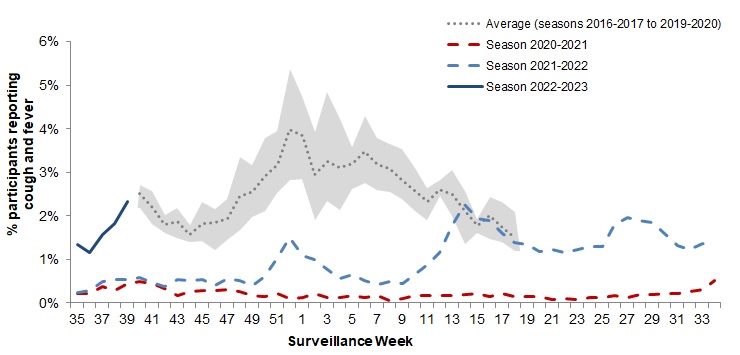
The shaded area represents the maximum and minimum percentage of percentage of participants reporting cough and fever by week, from seasons 2014-2015 to 2019-2020. Data from week 11 of the 2019-2020 season onwards are excluded from the historical comparison due to the COVID-19 pandemic.
Figure 6 - Text description
| Surveillance Week | 2022-2023 | 2021-2022 | 2020-2021 | Average | Min | Max |
|---|---|---|---|---|---|---|
| 35 | 1.3% | 0.2% | 0.2% | N/A | N/A | N/A |
| 36 | 1.2% | 0.3% | 0.2% | N/A | N/A | N/A |
| 37 | 1.6% | 0.5% | 0.4% | N/A | N/A | N/A |
| 38 | 1.8% | 0.5% | 0.3% | N/A | N/A | N/A |
| 39 | 2.3% | 0.5% | 0.4% | N/A | N/A | N/A |
| 40 | N/A | 0.6% | 0.5% | 2.5% | 2.2% | 2.7% |
| 41 | N/A | 0.5% | 0.4% | 2.2% | 1.8% | 2.6% |
| 42 | N/A | 0.4% | 0.3% | 1.8% | 1.6% | 2.0% |
| 43 | N/A | 0.5% | 0.2% | 1.9% | 1.5% | 2.2% |
| 44 | N/A | 0.5% | 0.3% | 1.6% | 1.4% | 1.8% |
| 45 | N/A | 0.5% | 0.3% | 1.8% | 1.4% | 2.3% |
| 46 | N/A | 0.4% | 0.3% | 1.8% | 1.2% | 2.2% |
| 47 | N/A | 0.6% | 0.3% | 1.9% | 1.4% | 2.4% |
| 48 | N/A | 0.5% | 0.3% | 2.4% | 1.7% | 3.4% |
| 49 | N/A | 0.4% | 0.2% | 2.6% | 2.0% | 3.2% |
| 50 | N/A | 0.6% | 0.1% | 2.9% | 2.1% | 3.8% |
| 51 | N/A | 1.0% | 0.2% | 3.2% | 2.5% | 3.9% |
| 52 | N/A | 1.5% | 0.1% | 4.0% | 2.8% | 5.4% |
| 1 | N/A | 1.1% | 0.1% | 3.8% | 2.9% | 4.8% |
| 2 | N/A | 1.0% | 0.2% | 2.9% | 1.9% | 3.9% |
| 3 | N/A | 0.8% | 0.1% | 3.3% | 2.3% | 4.8% |
| 4 | N/A | 0.6% | 0.1% | 3.1% | 2.1% | 4.2% |
| 5 | N/A | 0.6% | 0.2% | 3.2% | 2.6% | 3.6% |
| 6 | N/A | 0.5% | 0.1% | 3.5% | 2.8% | 4.3% |
| 7 | N/A | 0.4% | 0.2% | 3.2% | 2.6% | 3.8% |
| 8 | N/A | 0.5% | 0.1% | 3.1% | 2.5% | 3.6% |
| 9 | N/A | 0.5% | 0.1% | 2.8% | 2.4% | 3.5% |
| 10 | N/A | 0.6% | 0.2% | 2.6% | 2.1% | 3.1% |
| 11 | N/A | 0.9% | 0.2% | 2.3% | 1.9% | 2.6% |
| 12 | N/A | 1.2% | 0.2% | 2.6% | 2.5% | 2.8% |
| 13 | N/A | 1.8% | 0.2% | 2.5% | 2.0% | 3.1% |
| 14 | N/A | 2.3% | 0.2% | 2.1% | 1.3% | 2.6% |
| 15 | N/A | 1.9% | 0.2% | 1.8% | 1.6% | 1.9% |
| 16 | N/A | 1.9% | 0.1% | 2.0% | 1.5% | 2.4% |
| 17 | N/A | 1.6% | 0.2% | 1.7% | 1.4% | 2.3% |
| 18 | N/A | 1.4% | 0.2% | 1.5% | 1.2% | 2.1% |
| 19 | N/A | 1.3% | 0.1% | N/A | N/A | N/A |
| 20 | N/A | 1.2% | 0.2% | N/A | N/A | N/A |
| 21 | N/A | 1.2% | 0.1% | N/A | N/A | N/A |
| 22 | N/A | 1.2% | 0.1% | N/A | N/A | N/A |
| 23 | N/A | 1.2% | 0.1% | N/A | N/A | N/A |
| 24 | N/A | 1.3% | 0.1% | N/A | N/A | N/A |
| 25 | N/A | 1.3% | 0.1% | N/A | N/A | N/A |
| 26 | N/A | 1.8% | 0.2% | N/A | N/A | N/A |
| 27 | N/A | 2.0% | 0.1% | N/A | N/A | N/A |
| 28 | N/A | 1.9% | 0.2% | N/A | N/A | N/A |
| 29 | N/A | 1.8% | 0.2% | N/A | N/A | N/A |
| 30 | N/A | 1.6% | 0.2% | N/A | N/A | N/A |
| 31 | N/A | 1.3% | 0.2% | N/A | N/A | N/A |
| 32 | N/A | 1.2% | 0.3% | N/A | N/A | N/A |
| 33 | N/A | 1.4% | 0.3% | N/A | N/A | N/A |
| 34 | N/A | 1.3% | 0.5% | N/A | N/A | N/A |
Influenza Outbreak Surveillance
In week 39, there were no laboratory-confirmed influenza outbreaks in long-term care facilities in Canada.
To date this season (August 28, 2022 to October 1, 2022):
- 1 laboratory-confirmed influenza outbreak has been reported
- The outbreak was due to influenza A(H3N2) and was in a long-term care facility
- 3 ILI outbreaks have been reported
- All ILI outbreaks have been reported in schools and/or daycares.
Outbreaks of ILI are not specific to any one respiratory pathogen and can be due influenza, or other respiratory viruses, including respiratory syncytial virus, rhinovirus, and even COVID-19. Many respiratory viruses in addition to the flu commonly circulate during the fall and winter, and can cause clusters of cases with respiratory illness which could be captured as ILI.
Number of provinces and territoriesFootnote 1 reporting in week 39: 8 out of 13
Influenza Severe Outcomes Surveillance
Provincial/Territorial Influenza Hospitalizations and Deaths
In week 39, no influenza-associated hospitalizations and no ICU admissions were reported by participating provinces and territoriesFootnote 2.
To date this season (August 28, 2022 to October 1, 2022) among participating provinces and territories, no influenza-associated hospitalizations and no ICU admissions were reported.
Number of provinces and territories reporting in week 39: 6 out of 9
Pediatric Influenza Hospitalizations and Deaths
In week 39, less than 5 influenza-associated pediatric (≤16 years of age) hospitalizations were reported by the Immunization Monitoring Program Active (IMPACT) network.
To date this season (August 28, 2022 to October 1, 2022), less than 5 pediatric influenza-associated hospitalizations have been reported.
Influenza Strain Characterization
The National Microbiology Laboratory has not yet reported influenza strain characterization results for influenza viruses collected during the 2022-2023 season.
Antiviral Resistance
The National Microbiology Laboratory has not yet reported antiviral resistance results for influenza viruses collected during the 2022-2023 season..
Influenza Vaccine Monitoring
Vaccine monitoring refers to activities related to the monitoring of influenza vaccine coverage and effectiveness.
Vaccine Coverage
Influenza vaccine coverage estimates for the 2022-2023 season are anticipated to be available in February or March 2023.
Vaccine Effectiveness
Influenza vaccine effectiveness estimates for the 2022-2023 season are anticipated to be available in February or March 2023.
Provincial and International Surveillance Links
See Influenza surveillance resources
Notes
The data in the FluWatch report represent surveillance data available at the time of writing. All data are preliminary and may change as updates are received.
To learn more about the FluWatch program, see the Overview of influenza monitoring in Canada page.
For more information on the flu, see our Flu (influenza) web page.
We would like to thank all the FluWatch surveillance partners participating in this year's influenza surveillance program.
This report is available on the Government of Canada Influenza webpage.
Ce rapport est disponible dans les deux langues officielles.
- Footnote 1
-
All Provinces and Territories (PTs) participate in the FluWatch outbreak surveillance system. This outbreak system monitors influenza and ILI outbreaks in long-term care facilities(LTCF), acute care facilities, schools and daycares, remote and/or isolated communities, and facilities categorized as ‘other’. Not all reporting PTs report outbreaks in all these settings. All PTs report laboratory confirmed outbreaks in LTCF. Four PTs (NB, NL, NS and YK) report ILI outbreaks in schools and/or daycares and other facilities.
- Footnote 2
-
Influenza-associated hospitalizations are reported by Alberta, Manitoba, New Brunswick, Newfoundland and Labrador, Northwest Territories, Nova Scotia, Prince Edward Island and Yukon. Only hospitalizations that require intensive medical are reported by Saskatchewan.
